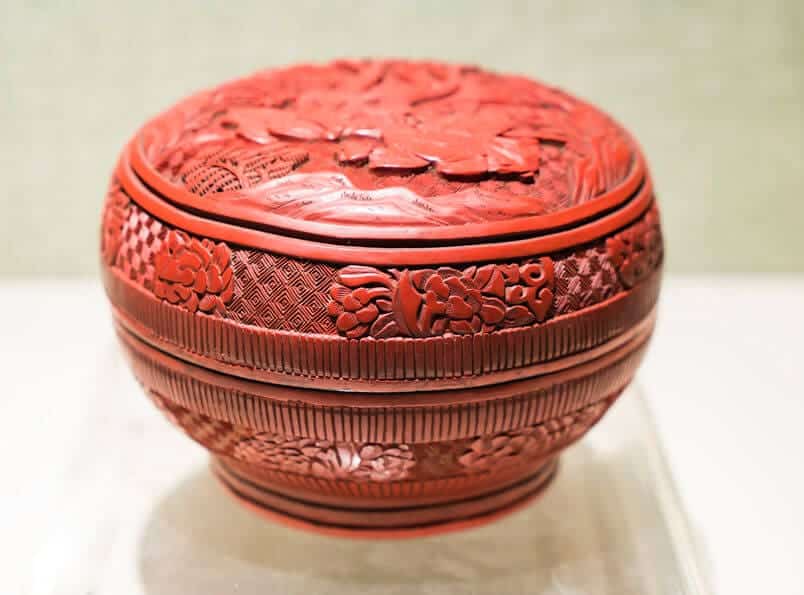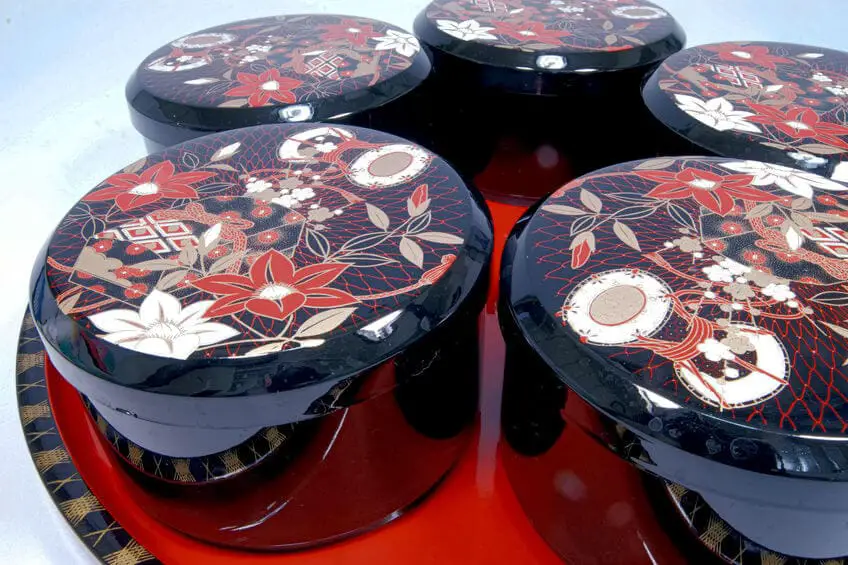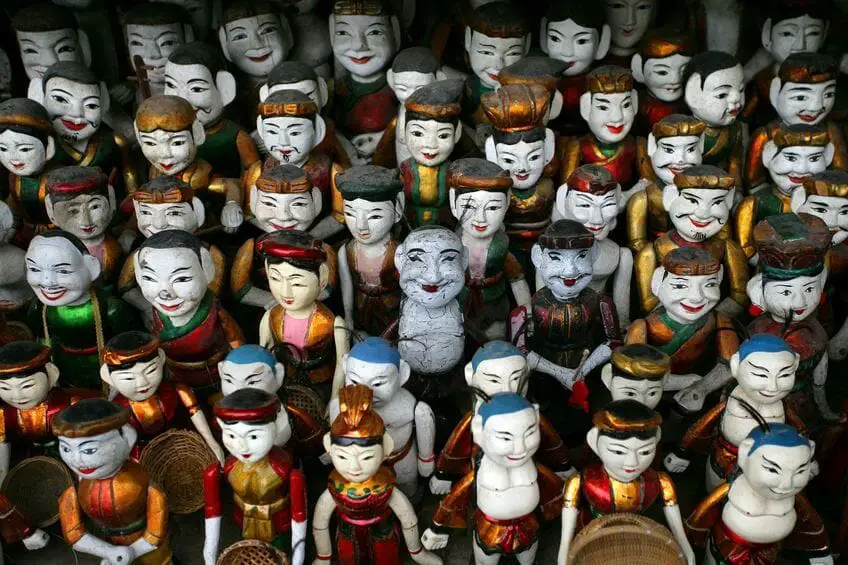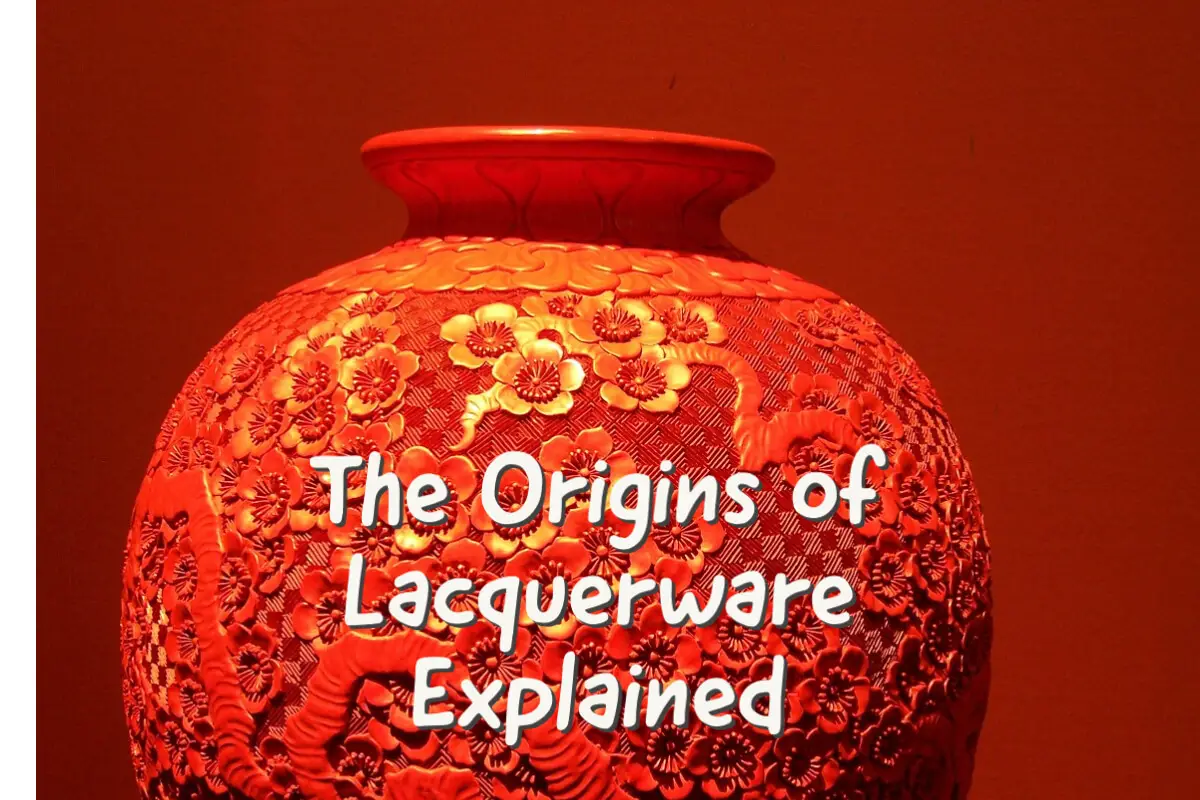Lacquerware is traditionally found throughout Asia. But experts do not always agree on where lacquerware originates from.
Lacquerware originated in China; some lacquerware has been found to have come from 10,000 BC. The Chinese brought the lacquerware technique to many other parts of Asia, in particular Japan and Vietnam. Each country has developed its lacquerware techniques, colors, and shapes. So, even though lacquerware originated in China, it is still unique to each country where it is manufactured. This is one reason why lacquerware has an interesting history and so many unique looks and finishes.
Table of Contents

Lacquerware and China
Lacquerware is originally from China. The Chinese then brought lacquerware production to other parts of Asia, such as Japan, Korea, and Vietnam.
Items covered in lacquer have been found in China dating to the Neolithic period, 10,000 BC. Chinese lacquerware was found during the Warring States Period (475–221 B.C.) using elaborate decoration.
In China, lacquerware took on two different forms – lacquer with decorative painting and carved lacquer; rarely are these two techniques of lacquerware painting and carving used in combination. The Chinese also started using surface decorations such as inlays with their lacquerware.
The earliest Chinese lacquerware objects were mainly black and red, also sometimes cinnabar or charcoal grey. Traditional Chinese lacquerware was quite a volatile paint substance; only a few additional coloring agents could be combined with it for a long time.
During the 10th century, there evolved to be other techniques with Chinese lacquerware, such as carved and then gilded with gold. The art of inlaying with mother pearl was also developed during the Song Dynasty (960-1127) in China.
The carving of lacquerware is a uniquely Chinese achievement in the look and way it is produced. The Chinese lacquerware carving technique flourished in the 13th and 15th centuries.
When you look at all these techniques that the Chinese developed, you can see how the Chinese lacquerware has influenced other parts of Asia. For example, Vietnam produces a lot of inlaid mother of pearl. Japan does a lot of painting on their lacquerware.
It can be said that the Chinese influenced lacquerware production throughout Asia. Even though lacquerware originates from China, other parts of Asia helped refine and develop lacquerware production to new levels.

Lacquerware and Japan
You can not speak about lacquerware without talking about Japanese lacquerware. The Japanese viewed lacquerware decoration differently than the Chinese. For Japanese lacquerware, the shape of the lacquered object is paramount to the entire art form.
The earliest lacquerware comes from Japan’s Nara Period (538 -794).
During this Nara period, the Japanese lacquerware began to take on a more decorative form and purpose. It was also when Japanese lacquerware started to become more refined with delicate gold and silver patterns.
Throughout history, the Japanese appreciated the durability of lacquerware. So, artisans began to use lacquer to coat many different materials such as wood, pottery, and baskets. They used lacquer to ensure these items were long-lasting and durable.
Over the years, Japanese lacquerware has started to take upon many different types of production techniques that are uniquely Japanese. In the 17th century, lacquer was applied to layers of paper molds.
The Japanese also added pigment to their lacquer paints to have more color choices, such as red, black, brown, green, and yellow.
In the true spirit of Zen decoration, the Japanese would use the lacquer as a topcoat for the wood so that the natural beauty of the wood would show through.
The Japanese have consistently developed their lacquerware techniques. Japanese lacquerware is even very popular today.

Lacquerware and Vietnam
Vietnam is another example of where the Chinese taught the Vietnamese how to manufacture lacquerware. Today, you can see many lacquer villages outside Hanoi, Vietnam, where the families have been producing lacquerware for hundreds of years.
Like the Japanese artisans, the Vietnamese craftsman also understood that lacquer could be durable. It was prevalent for people to have lacquerware items as it was cheaper than many other alternatives, such as brass or ceramic.
Vietnamese produce intricate water puppets out of lacquerware for their water puppet shows. These water puppets are carved from wood, and then lacquer is placed on them. This is why some of the Vietnamese lacquer is also waterproof in that they will use a waterproofing technique when they produce the lacquerware.
To discover more about Vietnamese lacquerware, you can read What Is Vietnamese Lacquerware? 11 Unknown Lacquerware Facts by clicking here.
At Mondoro, we really appreciate the unique look and feel of lacquerware. We are producing lacquerware in many of the handicraft villages outside Hanoi, Vietnam.
We go into these villages, and we help teach these highly skilled craftsmen trendy looks, colors, and techniques; this helps them keep their lacquerware skills alive.
Find out more about how Mondoro can help you create, develop, and manufacture excellent home decor and furniture products – don’t hesitate to contact me, Anita. Check out my email by clicking here or become a part of our community and join our newsletter by clicking here.
Mondoro gives out a FREE Lookbook to anyone interested. You can receive a copy of our latest Lookbook by clicking here.
Listen to our Podcast called Global Trade Gal. You can find it on all major podcast platforms. Try out listening to one of our podcasts by clicking here.
Subscribe to our Mondoro Company Limited YouTube Channel with great videos and information by clicking here.
Related Questions
How to Manufacture Vietnamese Lacquerware?
Vietnamese lacquer requires many manufacturing steps in the lacquer production process, including making the base, then preparing the lacquer base to be applied, to finally applying the lacquer paint onto the surface. Every piece must be carefully sanded to give it a very smooth surface. Vietnamese lacquerware production requires a lot of skill and knowledge.
To learn more you can read How to Manufacture Vietnamese Lacquerware? An Insider’s Guide to Lacquer by clicking here.
Why Is It Called Mother Of Pearl?
The name mother used in Mother of Pearl is thought to come from a nearly obsolete meaning of mother, which means “scrum, drugs or leftover fifth.” This would be because the Mother of Pearl comes from the leftover shell of the oyster, clam, or mussel. The scientific name for Mother Of Pearl is nacre.
You can discover more about Why Is It Called Mother Of Pearl? Pearls and Mother of Pearls by clicking here.


